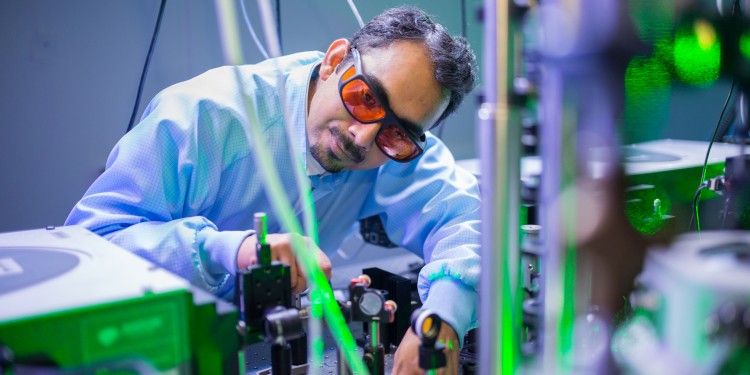
Playing with the wonder materials
The diameter of a hair, but a hundred thousand times thinner – the products made by Dr. Ashish Arora and his colleagues in the laboratories of the Institute of Physics are difficult to imagine for outsiders. The materials they deal with on a daily basis hold a world record because they consist of a single layer of atoms, the smallest building blocks of nature.
"Wonder materials," Ashish Arora calls them because they are so versatile. And because they have properties that are hard to believe: Graphene, for example, is an almost transparent substance and a hundred times stronger than steel. This one atom thick layer could, for example, carry the weight of a cat. Two Russian-British scientists were awarded the Nobel Prize in 2010 for their discovery of this layer of carbon atoms, which has been removed from graphite. "We are now playing with these materials on a regular basis," Ashish Arora chuckles. Of course, it's much more than just playing with the world of tiny things. The so called two-dimensional (2D) materials have been booming in research for years, because they could be of importance for many things in human everyday life in the future. Smartphones or computers, for example, are constantly becoming smaller and faster pushing the well-known semiconductors made of silicon, for example, to their limits.
“We need those 2D materials, where we could control the conductivity using electricity, or light,” stresses Ashish Arora. Fortunately, many such materials exist, either in nature, or could be created in the laboratory. Another popular example is Molybdenum disulfide which has been used as a dry lubricant in industry for many decades. Since it is incredibly conductive, it can be used for many novel technologies. Transparent touchscreens, flexible screens or novel batteries and computer chips are just a few examples. Many scientists are also focusing on their research in order to develop quantum computers that could solve problems in the future which classical computers could only solve with a great deal of time and energy, or could not solve at all.
Just as extraordinary as these "wonder materials" are, however, also are the machines needed to examine them and answer certain questions. "Only in high magnetic fields we can precisely and specifically answer some questions on 2D materials," explains Ashish Arora. This is one reason why once or twice a year he visits the few specialized institutions in the world. In Grenoble, France, for example, he and his colleagues find a static magnetic field that, at 30 Tesla, is 600,000 times stronger than the Earth's magnetic field. "You shouldn't wear watches, they're broken," the physicist tells. "It is even worse if these or other metallic objects accidentally fly through the air. Due to the strong attraction of the magnet, they develop a speed with which they can be life-threatening for those around them."
This information gives an impression of why such research facilities are called high magnetic fields. There are four of these special laboratories in Europe: Grenoble and Toulouse in France, Nijmegen in the Netherlands and Dresden. Each institution has a different focus, the research times there are fiercely contested among the scientists arriving all over the world. It costs around 1,000 euros to put the magnet into operation for one hour. This poses a challenge for Ashish Arora to be regularly able to convince an international committee of experts with his research projects in order to be allowed to work there at all.
An effort that pays off: Each approved application earns him and his team colleagues 40 to 80 hours of research time. Time to investigate and change the properties of so-called Valleys, certain physical states special to the 2D materials. The scientists address the Valleys with polarized light and ultimately hope to make them usable for future quantum technologies at room temperature. The work on the magnetic fields even resulted in Ashish Arora winning the research prize of the "European Magnetic Field Laboratory" this year, an organized association of the four laboratories.
"I love doing research and the opportunities we have," emphasizes the junior scientist from India, who has already made a long figurative journey for his work: After various positions abroad, an Alexander von Humboldt fellowship brought him to Münster a few years ago, followed by various grants from the German Research Foundation, through which he finances his current position as well. "I am very curious to see where our research will take us and how the resulting technical progress will affect people," he says. Because just as games usually have that in themselves, the outcome of playing with the wonder materials is still mostly open.
